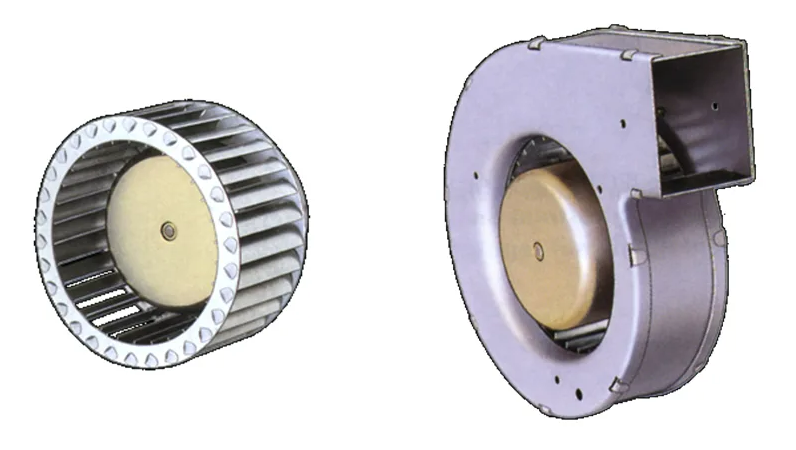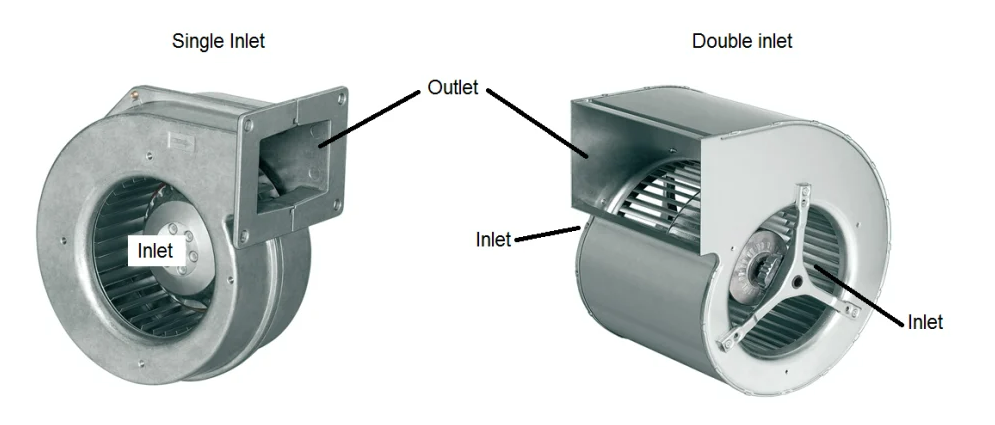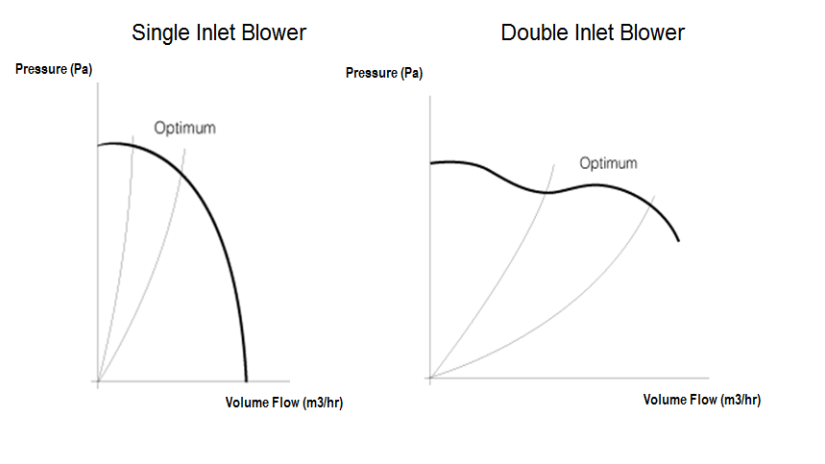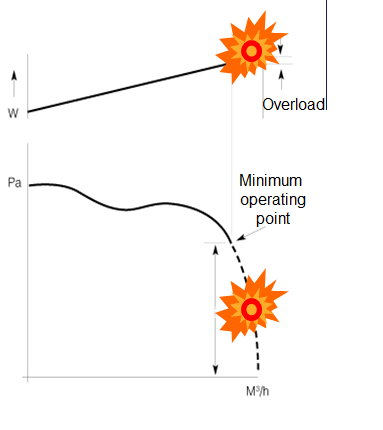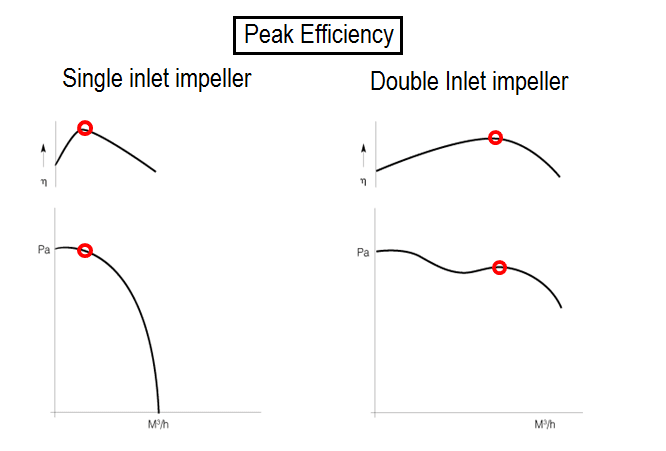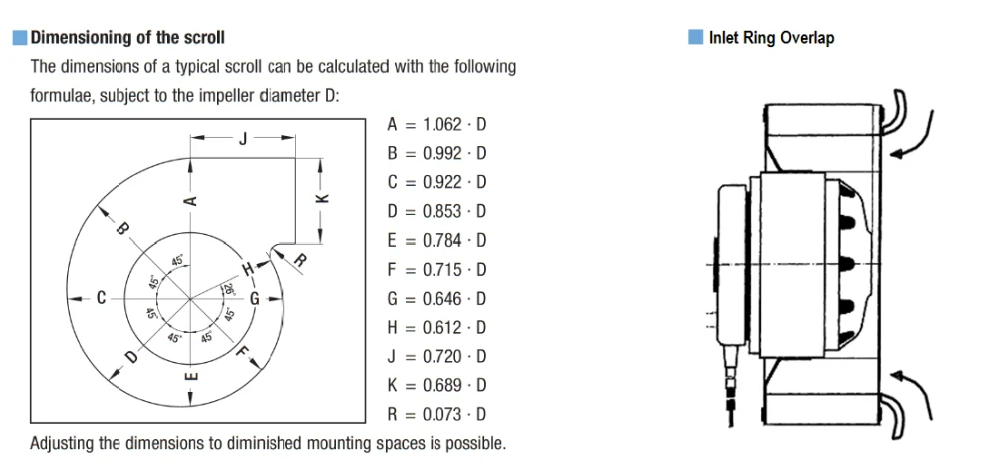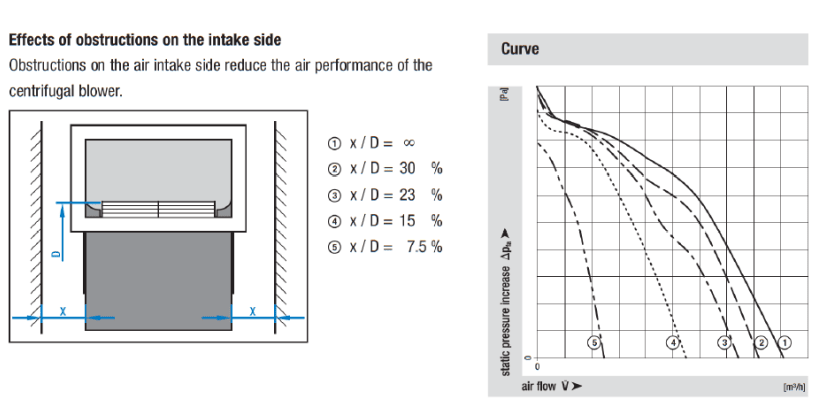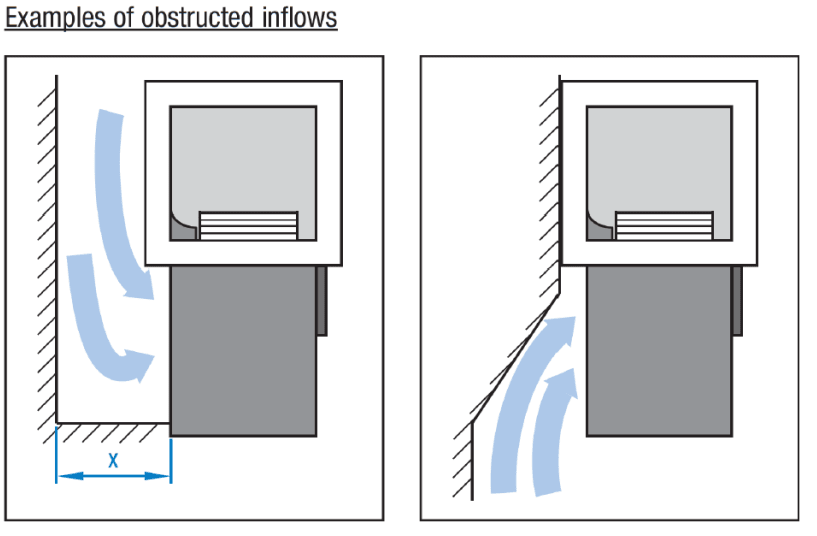Forward Curved Motorised Impeller
When we have defined the volume flow rate that we require, whether this is to provide fresh air or process cooling, we need to combine this with the resistance to flow that the fan will encounter in the application. The volume flow rate, (in m3/hr) and the pressure (in Pascals - Pa), are combined to become the duty point against which the fan must operate. It is important that we select a fan whose performance characteristic meets the required duty point on or near the point of peak efficiency. Using the fan at its peak efficiency minimises the power consumption and noise emitted from the fan whilst delivering the required performance.
How does Forward Curved Centrifugal Fan work?
The name, ‘Centrifugal Fan’ is derived from the direction of flow and how the air enters the impeller in an axial direction and then propelled outwards from the outer circumference of the fan. The difference in flow direction between a forward and backward curved centrifugal fan is the direction that the air exits the impeller circumference. With a backward curved impeller, the air exits in a radial direction whereas with a forward curved the air exits tangentially from the circumference of the fan.
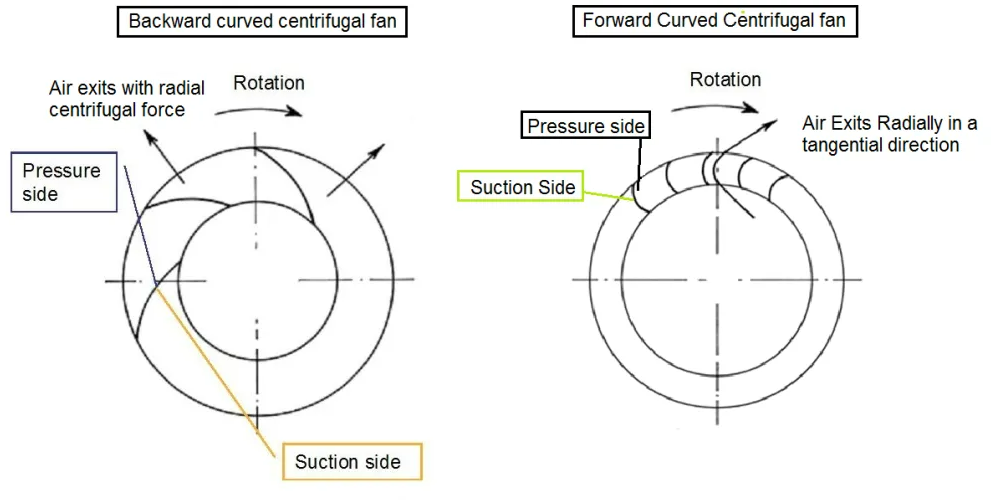
A forward curved centrifugal fan is characterised by its cylindrical shape and lots of small blades on the circumference of the impeller. In the example shown below, the fan rotates in a clockwise direction.
Unlike the backward curved impeller, the forward curved impeller requires a housing that converts high velocity air leaving the tips of the impeller blade into a lower velocity static force. The shape of the housing also directs the air flow to the outlet. This type of fan housing is commonly known as a scroll; however, it can also be referred to as a volute or a sirocco housing. By installing the forward curved impeller in a scroll housing, we usually refer to it as a forward curved blower.
There are two types of blowers that employ a forward curved motorised impeller as shown below…
The single inlet blower on the left, draws in air from one side of the housing through the round inlet and directs it to the square outlet, (seen here with a mounting flange). The double inlet blower has a wider scroll housing drawing air in from both sides of the scroll delivering it to the wider square outlet.
As with the backward curved centrifugal fan, the suction side of the impeller blade draws air from the centre of the fan which results in a directional change of the airflow between the inlet and the exhaust of 90o.
Fan Characteristic
The optimum operating area for a forward curved centrifugal fan is when it is operating at higher pressure. A forward curved centrifugal fan works best when high pressures against lower volume flows are required. The graph below illustrates the optimum working area…
The volume flow is plotted along the X-axis and the system pressure is plotted on the Y-axis. When there is no pressure in the system, (the fan is blowing freely), a forward curved centrifugal fan will produce the greatest volume flow. As a resistance to flow is applied to the suction or exhaust side of the fan, the volume flow rate will drop.
Caution should be exercised when selecting a forward curved blower to operate at low pressures and highest volume flow. At this point, the impeller is operating in an aerodynamic stall in the same manner as an axial fan operating in the saddle point of its curve. At this point noise and power consumption will be at its peak due to turbulence.
The peak efficiency is at a point called the knee of the characteristic curve. At this point the ratio of the output power of the fan (Volume flow (m3/s) x Static Pressure development (Pa) and the electrical power input (W) is at its greatest and the sound pressure being produced by the fan will be at its quietest. Above and below the optimum range of operation the flow across the fan becomes noisier and the efficiency of the fan system decreases.
The benefit of using a single inlet forward curved motorised impeller is that it has a steep fan characteristic. This is particularly useful in systems that require consistent levels of filtration. As air passes through a particulate filter the filter arrests airborne dust and pollen, the finer the grade of filtration the smaller the particles arrested by the filter. Over time the filter will become increasingly clogged with dirt and debris which has the effect that more pressure is required to deliver the same air volume. Using an impeller with a steep characteristic curve in this case means that as the filter becomes increasingly clogged, the volume flow remains constant while the pressure across the filter is increasing.
The benefit of using a double inlet forward curved impeller is that from a relatively small size blower it can deliver a high-volume flow. The compromise with using a double inlet blower is that it has a lower pressure development meaning that it can only work with lower pressure systems.
Mounting options
As mentioned previously, the forward curved motorised impeller produces high velocity air at the tips of the blade that needs to be directed and slowed to convert dynamic pressure into static pressure. To facilitate this, we build a scroll around the impeller. The shape is created by a ratio of distances from the centre of the impeller to the fan outlet. As with the backward curved fan it is also recommended to have a small overlap between the inlet ring and the mouth of the impeller. Both mounting considerations are shown in the diagram below…
The inlet ring diameter should only allow a small gap between impeller and ring to avoid recirculation of air.
Mounting considerations - Clearances
It is important to ensure sufficient clearance on the suction and side of the fan…
Insufficient clearance on the suction side of the fan will increase the inlet velocity which will lead to turbulence. This turbulence will be increased as the air passes through the impeller which makes the transfer of energy from the fan blade to the air less efficient, cause the creation of more noise and reduce the fan efficiency.
General recommendations for inlet and exhaust conditions are:
Inlet Side
- No obstruction or change in flow direction within 1/3rd a fan diameter distance from the inlet of the fan
Summary – Why Choose a forward curved centrifugal fan?
When the required duty point falls in the area of higher system pressures versus lower volume flow on the fan characteristic a single inlet forward curved centrifugal fan should be considered. If the requirement for the application is for a high-volume flow in a restricted space envelope a double inlet forward curved centrifugal fan should be considered.
The fan should be selected within its optimum range which is at what is known as the knee of its characteristic curve. The point of peak efficiency is in the closer to the higher-pressure limit on the fan characteristic curve where it is also being operating at its quietest. Operating outside of the optimum range (at the extremes of high volume flow) should be avoided as the turbulence and the aerodynamic efficiency of the impeller blade at these points will create noise and the impeller will also be operating in an aerodynamic stall. At low pressures and high-volume flows consideration should be given to the operating temperature of the motor under load as there is a potential for a motor overheat to occur.
Air on the inlet side of the impeller should be kept as smooth and laminar as possible. To maximise the efficiency at least a clearance of 1/3rd of the impeller diameter should be allowed on the fan inlet. Using an inlet ring (Inlet nozzle) overlapping the impeller inlet will help to eliminate flow disturbances before the air is drawn through the fan, reduce turbulence induced noise, keep the power consumption at the duty point to a minimum and maximise efficiency.
The steep operating characteristic, the higher-pressure capability of single inlet blowers and the high flow capability of double inlet blowers means that the forward curved fan is a useful option to consider across a wide range of installations.
Post time: Aug-16-2023

